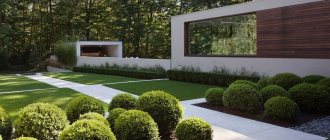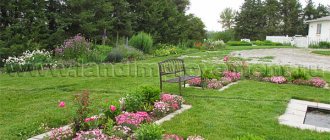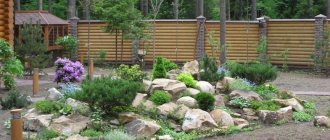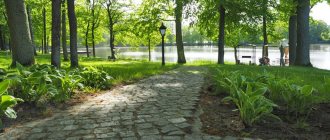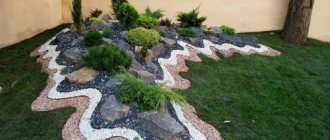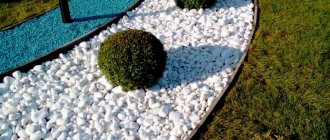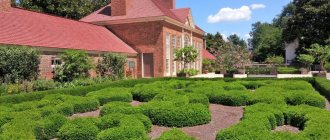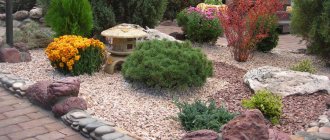An interesting decorative element, like a rock garden, is part of Buddhist art. This cannot be found in any other culture. Philosophical gardens, unusual for Europeans, are endowed with grace and attractive simplicity. A stone composition is an excellent option for decorating a summer cottage. Modern designers offer many ways to implement such an idea. In the homeland of stunning decor, Japan, only masters can install it. In our regions, anyone can install an unusual decoration in their dacha with their own hands.
What does history say?
The symbolic meaning of the stone has ancient roots. The religious schools of philosophy Zen Buddhism and Confucianism endow this part of inanimate nature with energy that carries calm, harmony and serenity. In Japan, the stone became an object of worship. This is where the idea of stone gardens originated.
At first, small compositions were made at monasteries and temples for contemplation and meditation. Today it is an element of the East in landscape design. But the Japanese still believe that such a miniature near the house will help achieve harmony with the world, avoid everyday problems and fuss.
Philosophy
Every detail of the composition is based on the teachings of Zen. It says that the world is as man sees it. By concentrating on a frozen picture, you can be alone with nature and hear your inner voice.
Photo: Japanese house
Zen masters claimed that if you look long at a stone lying on the sand with waves drawn around it, you can see how it slowly sinks into the water.
The classic version of a garden composition made of stones is created according to the principles of Feng Shui. It is based on 4 elements: air, earth, water and fire. The role of the last element can be played by decorative lanterns. If it is not possible to equip an artificial reservoir, sand with curved lines and circles in the form of waves will be an alternative.
The traditional picture is completed by ceramic figures, fences, and low-growing plants. Nearby there is a Japanese-style gazebo or pergola.
When creating a Japanese garden, it is important not to disturb the symmetry of the arrangement of parts and to avoid cluttering the space.
Types and styles
Rockery device
By type, rockeries are divided into stable and changeable:
- Stable ones require greater thoroughness during construction. Large stones are dug deep into the soil. Perennial plants are chosen and the crown is regularly given the desired shape
- Changeable rockeries are more dynamic and better suited for experimentation. They are made from small stones. Each year, different types of flowers are combined with a base of low-growing trees and shrubs, and new ornamental plants are planted.
Let's look at the main styles of rockeries: Japanese, European, English and tropical.
Japanese style
Japanese style
Japanese style Much attention is paid to minimalism and the combination of stones, rigor and restraint are emphasized. Plants play a secondary role, setting accents and highlighting the beauty of the stone. Green color predominates; it is important to choose pastel shades with smooth transitions for flowering plants. The style looks original, calms and encourages contemplation.
European style
European style
European style For design in a European style, you should choose plants that are common in the local landscape; bright flowering and climbing varieties are acceptable. There are no strict restrictions on the choice of plants and the shape of stones.
English style
English style
English style The emphasis is on maximum naturalness, picturesqueness and closeness of the composition to nature. Materials of various sizes are used - from small stones to massive boulders. Coniferous unpretentious plants predominate (arborvitae, juniper, dwarf spruce), which maintain an attractive appearance all year round. Greens - wormwood, cereals - go well with coniferous species.
Tropical style
Tropical style
Tropical style For the tropical type of rockery, bright vegetation is used that can obscure the stones. Plants are placed in several tiers. Tropical species, cacti, succulents will be required. The sprinkles can be laid out in the form of fancy patterns and decorated with ethnic figurines.
A stone flower garden does not always have a distinct style. You can make a beautiful garden using techniques from several varieties of rockeries.
The meaning of stones
The second name for this part of landscape design is karesansui. Translation: dry water and mountains.
Each element individually is responsible for a certain symbol:
- small pebbles, gravel or sand are water;
- flat stone - earth;
- high cobblestone - sky;
- massive rock pile – island or mountains.
In combination, they symbolize the grace of simplicity, due to which a different meaning is given to the surrounding world, and an analysis of values occurs.
Symbolism
The correct arrangement of stones in space is a real philosophy, the result of which can be a work of art - a finished sekitei. It represents a kind of world model:
- large stones - the personification of islands, mountains, large hills, rocks, cliffs;
- sand or pebble filling - the water surrounding them.
At the same time, the stones reflect the masculine principle, Yang energy, and symbolic water – the feminine Yin energy. All other decorations like paths, bridges, lanterns are just background.
The rock garden is a symbol:
- freedom;
- endless spaces;
- the perfection of nature;
- grace in simplicity.
Composition details
The selection of garden components is carried out very carefully, since all parts must be in harmony with each other.
Photo: park in Japan
Natural stone
The selection of these elements is carried out taking into account the shape, size, color and texture.
Their arrangement should suggest that the surface diagram is only a small part of the picture for contemplation, the larger one is located inside.
The Japanese rock garden uses volcanic rocks:
- granite;
- tuff;
- basalt;
- andesite;
- chlorite.
Photo: composition of stones
Stones are distinguished by shape:
- curved;
- flat;
- low vertical;
- recumbent;
- statues.
The Japanese identify a stone with a living being and believe that it has a face, behavioral dynamics and character.
Therefore, when creating such gardens, designers distinguish between stones that look up or down, run away, catch up, or lean against.
Photo: rock garden in the courtyard of the house
To make a high-quality composition, it is better to enlist the support of a specialist. If you lack experience, laying stones may not work and will look ridiculous.
Fencing
An important element of the picture. It means a desire for tranquility, a desire for privacy, which is why the fence is traditionally made opaque.
An interesting solution to create a fence from bamboo, tree branches, and climbing plants. You can carefully lay out partitions from cobblestones.
Lanterns
A decorative component responsible for lighting the garden.
Photo: stone lantern
Based on their appearance and purpose, there are several types:
- Ikekomi-gata. They are considered hidden lanterns. A stream of light is directed into the earth.
- Tachi-gata. Pedestal products. Their height ranges from 1 m to 3 m. They are used in large gardens. They are located in places where guests are received.
- Oki-gata. Small lanterns. They place it near the path leading to the gazebo or house.
- Yakimi-gata. Lanterns with a stone or concrete base. They have a square or round roof. To make the light flow softer, the body is made of frosted glass.
It is recommended to purchase lanterns made from natural materials so as not to disturb the harmony of the picture. Suitable pumice, wood, ceramics, stone.
Towers
This is an additional part of the garden, so such a figure should not be central to the composition. In accordance with this, its size is also selected.
Most often it is located near the tsukubai - a traditional Japanese mini-fountain. Material: stone. The tower has an odd number of tiers. Shape – four-, six-, octagonal or round.
Tsukubai
It is a bowl made of stone up to 30 cm high. Previously used in Japan for washing hands before the tea ceremony. Now it serves a purely decorative function. Install on a flat, low area.
Water enters the bowl through copper, PVC pipes, and hoses running under the ground.
Photo: stone bowl filled with spring water
If a tsukubai is fixed without a drainage system, the flowing water will form a fast stream. In this case, you should not place the product high - this is fraught with eroded sand and pebbles.
Retaining stone wall
Retaining walls will help to divide the site into separate zones or to play up relief features and height differences. They are laid out from a variety of materials (brick, artificial and natural stone). You can grow plants both in the axils of the wall itself and on its top, like in a garden bed.
Monumental retaining walls can be laid either with mortar or dry - the stones lie perfectly under their own weight without additional fastening.
If you plan to decorate the wall with flowers and herbs growing directly from the masonry, leave the axils small during construction (20x15x20). After the cement mortar has dried, it will be possible to fill them with soil and plant climbing, creeping rock crops.
If this option seems too labor-intensive, try leaving space for planting on the top side of the wall. To do this, continue laying the edges 20-25 cm in height, and leave the middle empty. It will be possible to pour soil into the resulting bed and grow almost any flowers, herbs and grains in it.
How to place stones on the site
Even when creating a simple garden, it is worth considering several features:
- All components of the picture are collected in groups. This is a good masking of individual defects.
- Preference is given to natural stones that have been exposed to precipitation, winds, and temperature changes. Their rounded features will make the composition softer and easier to perceive.
- Elements that are similar in color are selected.
- A prerequisite is an odd number of stones. Their number should be a multiple of three, five, best of all – fifteen pieces.
- The principle of a triad operates inside the painting: three stones in each group. It is important that the main group is combined with the landscape design, while others complement it.
- The presence of a point of contemplation in the composition. It is selected based on what time of day the owners plan to spend in the Japanese garden. Often the garden is located so that it is on the north side.
- Harmonious location relative to the entire site.
- Asymmetry of components.
- Maintaining line balance. There should be more horizontally installed stones than vertical ones.
- Contrast of free and filled space.
If the details of the composition are located correctly, then no matter which side a person stands on, he will see all the stones except the fifteenth. In Eastern philosophy, it is believed that only a select few who have comprehended the essence of the universe can contemplate the picture in full.
Imitation of natural rocky landscape
An option for the lazy, requiring minimal maintenance, is an imitation of a natural landscape. Essentially, these are just stones of different sizes, randomly scattered across the lawn and surrounded by vegetation.
In order to achieve this effect, you will need to get boulders of different sizes. Before placing stones, prepare the area - level it, remove weeds, and sow it with lawn grass.
You can leave the natural turf in the chosen area, removing only all aggressive and tall weeds.
Once all the boulders are in place, start planting the plants. Most cultivated small flowers will not be able to compete with natural grass cover, so give preference to coniferous, evergreen and unpretentious shrubs. If you definitely want to complement the greenery with bright colors, install mini-flower beds in the clearing, made of artificial stone with a recess or hollowed out in wood. You can plant annuals in them that will create bright accents, and after flowering ends they can be replaced or removed without any problems.
Caring for such a natural area comes down to watering during dry periods, fertilizing conifers and mowing the lawn.
Creating a Japanese rock garden with your own hands
Owners of suburban areas who want to try their hand at organizing part of the landscape design need to be patient and be extremely careful.
Photo: Japanese-style composition on a summer cottage
No permits are required to compose the composition, but having a plan for the painting will simplify the assembly process. Therefore, it is better to take a pencil and schematically depict the future decoration of the estate.
The procedure is as follows:
- The area is cleared of debris and weeds.
- The area is being leveled.
- The top layer of soil is removed to a depth of 15 cm.
- To strengthen it, bricks are laid around the perimeter or boards are attached.
- Sand up to 5 cm thick is poured onto the bottom.
- The remaining space is filled with gravel, pebbles, and white sand.
- To compact the contents, fill it with 1 bucket of water per 2 m2 of garden area.
- Stones are placed. They should take a stable position, be slightly pressed into the sand.
- Circular or wavy lines are made from stones, imitating water.
- The rest of the surface is leveled with a rake in vertical and horizontal stripes.
The composition will be complemented by a small perimeter fence, plants, tsukubai, and lanterns.
Step-by-step instruction
Installation of curb tape
1 After choosing a place for a rockery, prepare the area - level the area, remove turf (up to 20 cm), excess plantings and weeds
2 Mark the border, dig in, place border tape. The tape is firmly immersed in the soil and compacted on both sides.
3 Geospan, a synthetic textile ideal for landscape work, is placed in the recess for the rock garden. The material is adjusted along the edge of the border strip.
Laying geospan and placing large stones
4 The next stage is the installation of stones. They start with large boulders, trying to avoid symmetry, clear shapes and figures.
5 Think about the placement of plants, taking into account their further growth, and begin planting. Geotextiles are cut with scissors and the edges are folded. Dig a hole of sufficient size, add a fertile layer - soil, peat, drainage (crushed brick, expanded clay, sand) and other fillers required for each specific type.
Having completed these works, the geospan is folded back and covered with backfill. When planting plants, the order is observed - first, tree species are planted, then shrubs, and finally ground cover varieties.
Planting
6 The next step is to fill it with small stones in a layer of 5 cm. The material is selected based on what stones were used. If the rocks are rubble (dolomite, limestone, sandstone), then it is better to use crushed stone, and if there are round stones, then pebbles.
Filling with stones
7 Upon completion of the work, the composition is complemented with small stones and decorative elements.
Stone garden
8 The surface bordering the garden is covered with lawn - the greenery creates contrast and focuses attention on the rock garden. You can use seeded or rolled lawn.
Photo gallery of famous gardens
Let's consider several options for the arrangement of the elements of the picture.
Ryoanji Temple Rock Garden
Reanji is a monument of Zen Buddhism. Created in the XIV-XVI centuries in Kyoto. No matter how many historians try, the mystery of the composition still remains unsolved. This is a rectangular area filled with gravel. On top of it are wavy lines that play the role of the water element. But the basis of the picture is fifteen stones, divided into five groups.
Previously, the description indicated the lack of a clear structure in Reanji. But years of research have shown that this is a stone painting of tree branches, revealed to the beholder only from a certain angle.
Zen Garden in Karlovy Vary
Created on June 16, 1998 on the outskirts of a Czech resort town. Named in honor of Ghana Baltz, the wife of a German doctor who, at the request of the Emperor of Japan, laid the foundations of medicine in this country. Architect: Kinji Nomura.
The composition is made in the shape of a circle, divided in the middle by a line. This is the border between yin and yang. The garden is strewn with white gravel, symbolizing the ocean. One of the stones is shaped like a ship. The small cobblestone depicts Hana Baltz. A lantern is installed in the center of the composition - a symbol of light and help for those who have lost their way. Vertical statues are analogues of menhirs. This picture tells a whole story and attracts the attention of tourists from different countries.
Rock garden
Another name is alpine slide. It can be installed on a natural slope or an artificial mound of stones can be created. Flowers and shrubs are planted between the cobblestones. Previously, the list of plants for planting in rock gardens was limited to bulbous and low-growing perennials. Today, the owners assemble a composition from the plants they like.
The beauty of the eastern stone garden fascinates and brings inner harmony to the contemplator. This is an excellent choice for garden owners who want to see a piece of meditative Japanese culture in their garden.
Nuances of choosing plants
You can choose any plants for rock gardens. However, there are several particularly advantageous options:
- conifers (low-growing varieties of thuja, cypress, juniper);
- shrubs (cinquefoil, honeysuckle, cotoneaster);
- flowering perennials (violets, phlox, saxifrage);
- bulbous plants (tulips, crocuses, daffodils).
The planting order is as follows: first conifers, then shrubs, then flowers.
